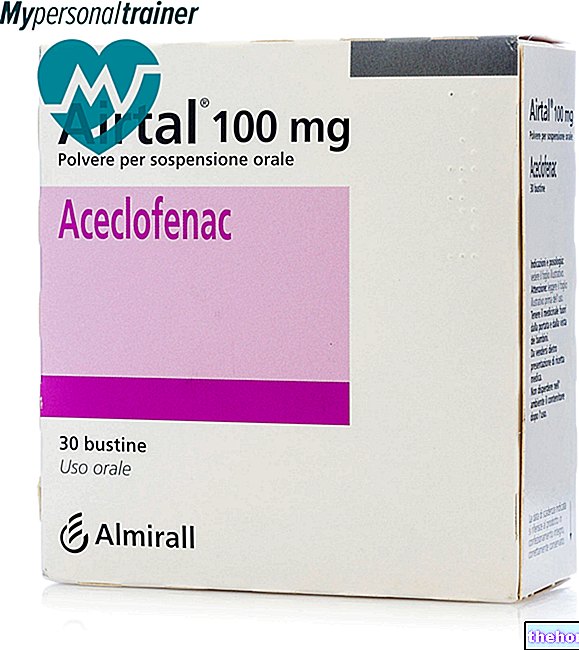Active ingredients: Amorolfine
ONILAQ 5% medicated nail polish
Why is Onilaq used? What is it for?
Pharmacotherapeutic class
ONILAQ 5% medicated nail polish is an antifungal (drug used to treat infections caused by microscopic fungi).
Therapeutic indications
ONILAQ 5% is used for the treatment of nail fungus (infections caused by fungi) in adults involving no more than 2 nails.
Generally a mycosis determines the discoloration of the nail (white, yellow or brown) and a thickening, even if the appearance can vary considerably.
If the infection is limited to the upper part of the nail as shown in photo n. 1 below, follow the instructions of the pharmacist. If the infection looks more like photo # 2 or 3, see your doctor.
Contraindications When Onilaq should not be used
Do not use ONILAQ:
- if you are allergic (hypersensitive) to the active substance (amorolfine) or to any of the other ingredients of ONILAQ.
- if you are under the age of 18.
Precautions for use What you need to know before you take Onilaq
Avoid contact with eyes, ears or mucous membranes.
Consult your doctor:
- if you have diabetes,
- if you are being treated for immune system disorders (a disorder that reduces the body's defenses),
- if you have circulatory problems in your hands and feet
- if you have a previous history of nail injury, skin conditions such as psoriasis, or other chronic skin condition, swelling, yellow nails associated with breathing disorders, sore nails, distorted / deformed nails
- any other ailments in the nail area.
- if the nail is severely damaged (with lesions exceeding two thirds of the nail plate) or infected. In these cases, your doctor may prescribe oral therapy in combination with medicated nail polish.
During treatment with amorolfine the use of cosmetic enamels or artificial nails should be avoided. In case of using organic solvents it is advisable to wear waterproof gloves so as not to remove the layer of medicated nail polish amorolfine.
This product contains ethanol (alcohol). Using the product too often or applying it improperly can cause irritation or dryness of the surrounding skin.
Interactions Which drugs or foods may change the effect of Onilaq
"Tell your doctor or pharmacist if you are taking, have recently taken, or might take any other medicines."
Warnings It is important to know that:
Pregnancy, breastfeeding and fertility
"If you are pregnant or breast-feeding, think you may be pregnant or are planning to have a baby, ask your doctor or pharmacist for advice before using this medicine."
Clinical experience with the use of amorolfine during pregnancy and / or breastfeeding is limited.
Amorolfine should not be used during pregnancy and / or breastfeeding unless clearly necessary
Dose, Method and Time of Administration How to use Onilaq: Posology
Before starting the treatment
Write down on the diagram below the portion of the nail affected by the infection. This will help to remember, in the control phase, how the nail looked like before the start of therapy. Every 3 months, write on the diagram how the affected area appears up to until the diseased nail has grown back completely. If there are two nails affected by the infection, take the most damaged nail as a reference. Take this Package Leaflet with you for consultation with your doctor or pharmacist.
Dosage
NAILS MUST BE TREATED ONCE A WEEK.
The treatment should continue until the healthy nail has grown back, usually it takes about 6 months of therapy for the fingernails and 9 to 12 months for the toenails.
Nails grow slowly, so it may take 2 to 3 months for you to notice any improvement. It is important to continue the treatment with medicated nail polish until the infection is completely resolved and the nail is completely regenerated.
If no improvement is observed after 3 months consult your doctor. Method of administration
Strictly follow the steps below for each nail to be treated.
1. Prepare the nail
Remove any previously applied nail polish with nail polish remover. With a nail file, file the entire surface of the nail, especially the infected area.
ATTENTION: in order to avoid the spread of the infection, do not use the same file to file healthy nails.Make sure no one uses his files.
2. Clean the nail
Use one of the cleaning swabs provided in the package to clean the nail. Save the cleaning swab which will be used later to clean the squeegee.
3. Treat the nail
Dip one of the reusable spatulas into the nail polish bottle. The nail polish should not be rubbed on the edge of the bottle. Apply the nail polish evenly over the entire surface of the nail. Let it dry for about 3 minutes.
Repeat the above procedure for each of the infected nails.
Before using the bottle next time, remove any previously applied layers of nail polish and file the nail again. Clean the nail with the cleansing swab and reapply the nail polish as indicated above.
After each application of ONILAQ:
- The spatula must be cleaned carefully using the cleaning pad provided. A spatula can be used several times, as long as it is thoroughly cleaned after each application to avoid contaminating other nails. Use the same swab used to clean the nail. Do not touch the treated nails with the cleansing swab
- Remove any polish that may have remained on the outside of the cap with a cleaning swab.
- Close the bottle by screwing it tightly.
- Discard the cleaning pad carefully as it is a flammable substance.
- Wash your hands thoroughly. However, if the nail polish is applied to the fingernails, wait until it is completely dry before washing.
Warnings
- Do not use artificial nails throughout the treatment period.
- Wait until the nail polish is dry before washing your hands or feet. When the enamel is dry, it is resistant to soap and water: therefore hands and feet can be washed as usual.
Duration of treatment
It is important to continue the treatment with medicated nail polish until the infection is completely resolved and the nail is completely regenerated. Generally it takes about 6 months of therapy for fingernails and 9 to 12 months for toenails. You will see the healthy nail grow back as the diseased nail shrinks.
If no improvement is observed after 3 months consult your doctor.
IMPORTANT
- If ONILAQ, 5% medicated nail polish comes into contact with eyes or ears, rinse immediately with water, and immediately consult your doctor, pharmacist or go to the nearest hospital.
- Avoid contact with mucous membranes (e.g. mouth or nostrils). Do not inhale the nail polish.
- If you or others accidentally swallow the nail polish, contact your doctor, pharmacist or the nearest hospital immediately.
Overdose What to do if you have taken too much Onilaq
Not relevant.
Side Effects What are the side effects of Onilaq
Like all medicines, ONILAQ 5% medicated nail polish can cause side effects, although not everybody gets them.
Reactions to the medicine are rare. Certain nail abnormalities (nail discoloration, nail brittleness), skin burning sensation, redness, itching, hives, blisters and allergic skin reactions have been reported. However, these reactions may be directly related to nail infection.
Rare: may affect up to 1 in 1000 people
Nail damage, nail discoloration, nail brittleness.
Very rare: may affect up to 1 in 10,000 people Burning sensation of the skin.
Not known: frequency cannot be estimated from the available data Redness, itching, hives, blistering and allergic skin reactions.
Reporting of side effects
"If any of the side effects get serious, or if you notice any side effects not listed in this leaflet, please tell your doctor or pharmacist." You can also report side effects directly via the national reporting system at https://www.aifa.gov.it/content/segnalazioni-reazioni-avverse By reporting side effects you can help provide more information on the safety of this medicine
Expiry and Retention
Keep this medicine out of the sight and reach of children.
Do not use the medicine after the expiration date which is stated on the bottle and on the carton after Expiry. The expiry date refers to the last day of the month.
Keep the medicine away from heat sources. Close the bottle by screwing the cap tightly after each application.
Medicines should not be disposed of via wastewater or household waste. Ask your pharmacist how to throw away medicines you no longer use. This will help protect the environment.
Composition and pharmaceutical form
What ONILAQ contains:
The active ingredient is: amorolfine
ONILAQ medicated nail polish contains 50 mg / ml (5% w / v) of the active ingredient amorolfine (as amorolfine hydrochloride)
The excipients are:
copolymer of methacrylic acid (EUDRAGIT RL100), triacetin, butyl acetate, ethyl acetate, absolute ethyl alcohol.
HOW ONILAQ IS PRESENT AND CONTENTS OF THE PACKAGE
The package contains 1 bottle of 2.5 ml of medicated nail polish, spatulas, cleaning pads and nail files.
Source Package Leaflet: AIFA (Italian Medicines Agency). Content published in January 2016. The information present may not be up-to-date.
To have access to the most up-to-date version, it is advisable to access the AIFA (Italian Medicines Agency) website. Disclaimer and useful information.
01.0 NAME OF THE MEDICINAL PRODUCT
ONILAQ 5% MEDICATED NAIL POLISH
02.0 QUALITATIVE AND QUANTITATIVE COMPOSITION
ONILAQ 5% medicated nail polish contains 5% w / v (50 mg / ml) of amorolfine as amorolfine hydrochloride
For the full list of excipients, see section 6.1.
03.0 PHARMACEUTICAL FORM
Medicated nail polish.
Clear colorless to nearly colorless liquid
04.0 CLINICAL INFORMATION
04.1 Therapeutic indications
Treatment of distal and lateral subungual onychomycosis of mild entity caused by dermatophytes, yeasts and molds involving no more than two adult fingernails.
04.2 Posology and method of administration
Dosage
Apply ONILAQ to affected nails once a week.
Method of administration
Apply the nail polish by carefully observing the following recommendations:
A. Before starting the first treatment with ONILAQ, clean your nails thoroughly. Remove any layers of nail polish previously applied with a nail polish remover; then with a nail file, file the nail surface (in particular the affected nail surface) as accurately as possible. Be careful not to file the peri-nail skin area.
B. The nail surface must be cleaned and degreased using one of the cleaning pads (supplied).
C. With one of the applicators supplied (reusable) apply the enamel on the entire surface of the nail. Between an application and the other, clean the applicator with the cleaning pad supplied, in order to avoid contaminating the nail lacquer. Do not rub the applicator on the edge of the bottle itself.
D. The applicator must be thoroughly cleaned with a cleaning swab after each application before proceeding with the treatment of another nail to avoid contaminating the nail polish.
E. If the enamel comes into contact with the outside of the cap, clean with a cleaning swab provided to avoid contact with the skin.
F. Keep the bottle tightly closed.
Repeat the process for each of the affected nails.
After each application of ONILAQ, it is important to wash your hands. If you are applying it to your fingernails, wait until the polish is completely dry before washing.
The treatment should be continued without interruption until the nail has regenerated.
In general it takes 6 months of therapy for the fingernails and 9 months for the toenails (the duration essentially depends on the intensity, location and extent of the infection).
After 3 months of treatment without results, consult your doctor.
Special instructions :
• Files used for diseased nails should not be used for healthy nails.
• Before each new application, remove any nail polish residue, file affected nails if necessary and then always clean them with a cleaning pad.
04.3 Contraindications
Hypersensitivity to the active substance or to any of the excipients listed in section 6.1.
04.4 Special warnings and appropriate precautions for use
Special warnings :
Avoid any contact of ONILAQ with eyes, ears or mucous membranes.
Treatment must be established by the physician in the case of patients with peripheral vascular disease, diabetes, diseases of the immune system, as well as in patients with nail dystrophy or severely damaged nails (with lesions of more than two thirds of the nail plate). In these cases, systemic therapy should be envisaged.
Patients with a past history of lesions, skin conditions such as psoriasis or other chronic skin condition, edema, respiratory distress (Yellow Nail Syndrome), sore nails, distorted / deformed nails or other symptoms should seek medical attention before starting treatment.
Cosmetic polish or artificial nails should not be used during treatment with amorolfine.
In case of using organic solvents, it is good to wear waterproof gloves so as not to remove the layer of medicated nail polish amorolfine.
Precautions for use :
In the absence of clinical data, ONILAQ is not recommended for use in patients below 18 years of age.
04.5 Interactions with other medicinal products and other forms of interaction
The data currently available do not highlight the existence of clinically relevant interactions.
04.6 Pregnancy and lactation
Clinical experience with the use of amorolfine during pregnancy and / or breastfeeding is limited.
Only a few cases of exposure to topical use of amorolfine in pregnant women have been reported during the post-authorization period, therefore the potential risk is unknown.
Studies in animals have shown reproductive toxicity at high oral doses (see section 5.3); it is not known whether amorolfine is excreted in human milk.
Amorolfine should not be used during pregnancy and / or breastfeeding unless clearly necessary.
04.7 Effects on ability to drive and use machines
Not relevant.
04.8 Undesirable effects
Adverse reactions noted are rare.
Reporting of suspected adverse reactions
Reporting of suspected adverse reactions occurring after authorization of the medicinal product is important as it allows continuous monitoring of the benefit / risk balance of the medicinal product. Healthcare professionals are asked to report any suspected adverse reactions via the national reporting system. "address: http://www.agenziafarmaco.gov.it/it/responsabili
04.9 Overdose
No systemic overdose reactions are expected following topical administration of ONILAQ.
In case of accidental ingestion, appropriate measures should be taken to treat symptoms.
05.0 PHARMACOLOGICAL PROPERTIES
05.1 Pharmacodynamic properties
Pharmacotherapeutic group: other antifungals for topical use.
ATC code: D01AE16
ONILAQ is a topical antifungal. The active ingredient amorolfine, a derivative of morpholines, belongs to a new chemical class of antifungals. Its fungistatic and fungicidal effect is based on the alteration of the membrane of the fungal cell and in particular on the biosynthesis of sterols. The ergosterol content is reduced. The accumulation of atypical sterols leads to morphological modifications of cell membranes and organelles, which induce lysis of the fungal cell.
Amorolfine has a broad spectrum of antifungal action. It is particularly effective against usual and occasional agents that cause onychomycosis:
• Yeasts:
- Candida Albicans and other types of Candida.
• Dermatophytes:
- Tricophyton Rubrun, Tricophyton Interdigital And Tricophyton Menthagrophytes other Tricophyton species,
- Epidermohpyton floccosum,
- Microsporum.
• Molds:
- Scopulariopsis
• Dematiacea ("Black Mushrooms"):
- Hendersonula, Alternaria, Cladosporium.
• Less sensitive species:
- Aspergillus, Fusarium, Mucorales.
05.2 Pharmacokinetic properties
Amorolfine, in the form of medicated nail polish, penetrates and spreads through the surface of the nail and in this way is able to eliminate the fungi present in the nail bed that would otherwise be difficult to access.
The systemic absorption of the active ingredient is negligible. The plasma concentration remains below the detection threshold even after one year of use.
05.3 Preclinical safety data
Studies in rats and dogs were conducted with an oral dosage of amorolfine up to 60 mg / kg bw / day for 13 weeks or with a dosage of up to 40 mg / kg bw / day for 26 weeks.
From the dose of 40 mg / kg body weight / day, keratoderma and dermatosis-like skin lesions, hyperkeratosis of the mucous membranes and skin / mucous membrane transition have been observed.
Reproductive toxicity studies conducted on laboratory animals have shown teratogenicity, embryotoxicity and foetotoxicity but these effects were observed at exposures much higher than human exposure, indicating no foreseeable risk in pregnancy.
The potential risk of genotoxicity of amorolfine was evaluated in vitro and in vivo.
No potential risk of genotoxicity was observed.
Carcinogenicity studies have not been conducted.
Topical administration of medicated nail polish amorolfine on animals has shown dermal toxicity under occlusive conditions. Medicated nail polish amorolfine does not induce sensitization.
06.0 PHARMACEUTICAL INFORMATION
06.1 Excipients
Copolymer of methacrylic acid type A (EUDRAGIT RL100),
Triacetin
Butyl acetate
Ethyl acetate
Absolute ethyl alcohol.
06.2 Incompatibility
Not relevant.
06.3 Period of validity
3 years.
06.4 Special precautions for storage
Keep the bottle away from heat sources.
Close the bottle by screwing it tightly after use.
06.5 Nature of the immediate packaging and contents of the package
Screw-closed type I amber glass bottle with HDPE cap
2.5 ml bottle complete with accessories (30 nail files, 30 cleansing pads, 30 applicators).
06.6 Instructions for use and handling
No special instructions.
07.0 MARKETING AUTHORIZATION HOLDER
GALDERMA Italia S.p.A. - Registered office - Via dell "Annunciata, 21 - Milan
08.0 MARKETING AUTHORIZATION NUMBER
ONILAQ "5% medicated nail polish", 1 glass bottle of 2.5 mL with accessories (30 nail files, 30 cleansing pads, 30 applicators), AIC 041906013.
09.0 DATE OF FIRST AUTHORIZATION OR RENEWAL OF THE AUTHORIZATION
September 2012
10.0 DATE OF REVISION OF THE TEXT
December 2014
11.0 FOR RADIO DRUGS, COMPLETE DATA ON THE INTERNAL RADIATION DOSIMETRY
Not relevant.
12.0 FOR RADIO DRUGS, FURTHER DETAILED INSTRUCTIONS ON EXEMPORARY PREPARATION AND QUALITY CONTROL
Not relevant.




























